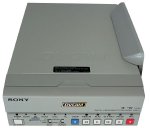|

Inside
the magazine
Self-help message board
Article reprints
How to contact us
Web links directory
Software downloads
Tips and advice
Fire-wire campaign
Subscribe today
Help Me, I'm new!
Fair pricing petition
Home

In
Software Downloads:
Adobe
Premiere 6 (trial)
Paint Shop Pro 7 (trial)
Tips
and Advice:
How to get started with
computer video editing
Fire-wire
Campaign:
Join our ongoing campaign
|
Sony
DSR-11
Video editors
looking for a good DV deck aren't short of choice these days. Sony's
MiniDV Walkman decks have proven to be immensely successful, and we
expect the Digital8 equivalents to prove just as popular. Panasonic's
NV-DV2000 was another winner when we reviewed it in October 2000. All
these machines are easily found in good camcorder shops, and sell at
reasonable prices.
 Slightly
less commonplace is Sony's professional range of DVCAM devices. The
DSR-11 is Sony Professional's entry-level machine, costing around the
same price as a good three-CCD camcorder. As a format, DVCAM is very
similar to the less costly consumer MiniDV. Both use the same method
of compression, with video running at 3.6MBytes per second. The formats
also use the same kind of tape. However, DVCAM uses more tape than DV,
scanning at a faster speed. A 60-minute MiniDV tape will last only 40
minutes when used to make a DVCAM recording. The faster scanning speed
has advantages in helping prevent audio and video dropouts, but won't
result in a better picture. In addition, DVCAM has a tighter sync lock
between audio and video. As we've never seen audio sync slip in DV recordings,
we don't really regard this as a great reason to buy DVCAM over DV.
Professional DVCAM cassettes are available, and will work with DV devices
too. These tapes tend to be more robust than their consumer MiniDV counterparts. Slightly
less commonplace is Sony's professional range of DVCAM devices. The
DSR-11 is Sony Professional's entry-level machine, costing around the
same price as a good three-CCD camcorder. As a format, DVCAM is very
similar to the less costly consumer MiniDV. Both use the same method
of compression, with video running at 3.6MBytes per second. The formats
also use the same kind of tape. However, DVCAM uses more tape than DV,
scanning at a faster speed. A 60-minute MiniDV tape will last only 40
minutes when used to make a DVCAM recording. The faster scanning speed
has advantages in helping prevent audio and video dropouts, but won't
result in a better picture. In addition, DVCAM has a tighter sync lock
between audio and video. As we've never seen audio sync slip in DV recordings,
we don't really regard this as a great reason to buy DVCAM over DV.
Professional DVCAM cassettes are available, and will work with DV devices
too. These tapes tend to be more robust than their consumer MiniDV counterparts.
We first heard of the DSR-11 at the end of 2000, and were instantly
intrigued by its price and claimed versatility for the DV editor. The
machine records and plays back DV and DVCAM video, accepting MiniDV
tapes (as used in most camcorders) and longer full-sized cassettes.
What's more, it has the ability to be switched from PAL to NTSC - a
very attractive feature for those preparing videos for both sides of
the Pond.
Despite our misgivings regarding the machine's lack of display panel,
and annoying dependency on the remote control, we have to admit to liking
the DSR-11. For those working purely with MiniDV, and making short movies,
this machine may not be the right choice, however. Sony DV Walkman decks
are far cheaper, and the Panasonic DV2000 has the blessing of having
a lower price-tag and more AV sockets than you're ever likely to need.
In terms of connectivity, the DSR-11 is quite basic, but it truly shines
in its potential as a deck for video mastering, and as part of a DIY
duplication setup for PAL and NTSC copying. Its support of two world
standards, two formats and full-size DV tapes make it worth every penny
of its street price for those looking for a reliable, robust, all-purpose
machine.
More in the June
2001 issue of Computer Video Magazine
|
Recent features...
View
The Archive
Reviewed in June's
issue:
Matrox Marvel G450 eTV
ATI All-In-Wonder Radeon
Sony DSR-11
Panasonic
AG-DVC15
In June's news:
FAST goes the jugular
MGI turns the tables
Matrox one-card trick
iBook grows up
All about DVD-R
|





 Slightly
less commonplace is Sony's professional range of DVCAM devices. The
DSR-11 is Sony Professional's entry-level machine, costing around the
same price as a good three-CCD camcorder. As a format, DVCAM is very
similar to the less costly consumer MiniDV. Both use the same method
of compression, with video running at 3.6MBytes per second. The formats
also use the same kind of tape. However, DVCAM uses more tape than DV,
scanning at a faster speed. A 60-minute MiniDV tape will last only 40
minutes when used to make a DVCAM recording. The faster scanning speed
has advantages in helping prevent audio and video dropouts, but won't
result in a better picture. In addition, DVCAM has a tighter sync lock
between audio and video. As we've never seen audio sync slip in DV recordings,
we don't really regard this as a great reason to buy DVCAM over DV.
Professional DVCAM cassettes are available, and will work with DV devices
too. These tapes tend to be more robust than their consumer MiniDV counterparts.
Slightly
less commonplace is Sony's professional range of DVCAM devices. The
DSR-11 is Sony Professional's entry-level machine, costing around the
same price as a good three-CCD camcorder. As a format, DVCAM is very
similar to the less costly consumer MiniDV. Both use the same method
of compression, with video running at 3.6MBytes per second. The formats
also use the same kind of tape. However, DVCAM uses more tape than DV,
scanning at a faster speed. A 60-minute MiniDV tape will last only 40
minutes when used to make a DVCAM recording. The faster scanning speed
has advantages in helping prevent audio and video dropouts, but won't
result in a better picture. In addition, DVCAM has a tighter sync lock
between audio and video. As we've never seen audio sync slip in DV recordings,
we don't really regard this as a great reason to buy DVCAM over DV.
Professional DVCAM cassettes are available, and will work with DV devices
too. These tapes tend to be more robust than their consumer MiniDV counterparts.